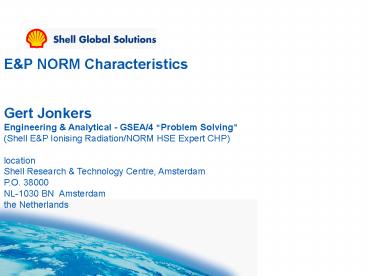E - PowerPoint PPT Presentation
1 / 15
Title:
E
Description:
G. Jonkers, GSEA/4 at SRTCA. P.O. Box 38000, 1030 BN Amsterdam. Cosmogenic NOR's. induced by interaction between particle radiation' and elements in the outer ... – PowerPoint PPT presentation
Number of Views:37
Avg rating:3.0/5.0
Title: E
1
EP NORM Characteristics Gert
Jonkers Engineering Analytical - GSEA/4
Problem Solving (Shell EP Ionising
Radiation/NORM HSE Expert CHP) location Shell
Research Technology Centre, Amsterdam P.O.
38000 NL-1030 BN Amsterdam the Netherlands
2
Naturally Occurring Radionuclides (NORs) vs.
Anthropogenic Radioactivity
- Cosmogenic NORs
- induced by interaction between particle
radiation and elements in the outer atmosphere
(ionosphere) thereby generating Naturally
Occurring Radionuclides - 3H (T1/2 14 y), 7Be (53 d), 14C (5730 y), etc.
- e.g. 14N 1n 1p 14C
- Terrestrial NORs
- radionuclides, which have been present ever
since the planet Earth was formed some 4.5 ? 109
years ago - 40K (1.28 ? 109 y), 87Rb (5 ? 1011 y), 232Th
(1.41 ? 1010 y), - 235U (7.04 ? 108 y), 238U (4.47 ? 109 y)
7 0 1 6
3
EP RELEVANT TERRESTRIAL NORs 40K and 232Th-,
235U- 238U- decay series
RADIOACTIVITY Becquerel (1 nuclear
disintegration/s) SI unit for total amount of
radioactivity (Bq), or concentration of
radioactivity (Bq/g or Bq/L) Half-Life time
period, in which the total activity or activity
concentration, is reduced to half its
value PHYSICS/CHEMISTRY activity-mass conversion
factors 00031.2 Bq40K/gK 04060.0
Bq232Th/gTh 00572.0 Bq235U/gU 12600.0
Bq238U/gU
?
40K 1.3 ? 109 y
ltlt Low abundance, ltlt homeostatic take up
0.01
232Th 1.4 ? 1010 y
100.00
235U 4.5 ? 108 y
0.27
ltlt Low abundance
238U 4.5 ? 109 y
99.72
4
K, Th and U Concentrations in Sedimentary Rocks
5
TERRESTRIAL NORs 232Th- 238U- Decay Series
238U 109 y
Primordial NORs 232Th and 238U are
special Heading a Series of Successive Nuclear
Decays
99.7
234Th
234mPa
234U
232Th 1010 y
230Th
- Relevant Gas/Oil Time Scales
- Diagenesis gt 106 years
- Reservoir Accumulation gt 105 years
- Production 50 years
- (Gas) Transport Time days
100
228Ra 6 y
226Ra 1600 y
228Ac
222Rn 4 d
228Th 2 y
218Po
224Ra 4 d
214Pb
220Rn
214Bi
216Po
214Po
212Pb
210Pb 22 y
212Bi
210Bi
Half-lives lt 1 week too short to develop the
chemistry of the element
212Po 208Tl
210Po 138 d
206Pb stable
208Pb stable
6
Secular Equilibrium
238U
- Secular equilibrium is radioactive equilibrium,
in which the parent activity does not decrease
significantly during many daughter half lives. A
steady state is established in which the rate of
formation of the daughter nuclides is just equal
to their rate of decay. - The rate of decay, i.e. de number of
disintegrations per second or Bq, of all
radionuclides in a series in secular equilibrium
will be the same as that of the parent. - The shorter-lived daughters then appear to decay
with the half-life of the long-lived parent. - If undisturbed the daughters of the 238U-decay
series all appear to decay with the half-life of
uranium being 4.5 109 years.
234Th
234mPa
234U
230Th
226Ra
222Rn
218Po
214Pb
214Bi
214Po
210Pb
210Bi
210Po
206Pb
7
Disturbed Secular Equilibrium
238U
- If a system is not closed to radionuclide
migration the secular equilibrium will become
disturbed. The migrated daughter nuclide will
start a decay series for its own, so-called
sub-series will be formed.
234Th
234mPa
234U
230Th
- For example a system
consists of a formation
with entrapped pore water. As waters start to
move, dissolved radium-ions may be transported to
somewhere far from the originating formation,
i.e. far from its parent 238U. Consequently, no
ingrowth of 226Ra anymore by nuclear decay gt
unsupported. - 226Ra will form a new secular equilibrium with
its short-lived daughters gt 226Ra or 226Raeq
sub-series.
226Ra
226Ra
222Rn
222Rn
218Po
218Po
214Pb
214Pb
214Bi
214Bi
214Po
214Po
210Pb
210Pb
210Bi
210Bi
210Po
210Po
206Pb
206Pb
8
232Th- 238U- Decay Series Member Transport
9
EP NORM CHARACTERISTICS - 238U decay series
238U 109 y
234Th
NOR transport with reservoir material only
234mPa
234U 105 y
230Th 105 y
Leaching transport via water
226Ra
226Ra 1600 y
Emanation / Dissolution transport with gas /
(oil/water)
c)
222Rn
222Rn
222Rn 4 d
218Po
218Po
218Po
Leaching (Pb carrier) transport via water
electrochemical deposition
214Pb
214Pb
214Pb
214Bi
214Bi
214Bi
e)
214Po
214Po
mechanism?transport via NGL/condensate
214Po
210Pb
210Pb
210Pb
210Pb 22 y
210Bi
210Bi
210Bi
210Bi
210Po
210Po
210Po
210Po
210Po 138 d
206Pb
206Pb
206Pb
206Pb
206Pb stable
10
EP NORM CHARACTERISTICS - 232Th decay series
a)
NOR transport with reservoir material only
232Th 1010 y
b)
Leaching transport with water
228Ra 6 y
228Ra
228Ac
228Ac
228Th 2 y
228Th
c)
Leaching transport with water
224Ra 4 d
224Ra
224Ra
Emanation / Dissolution transport with gas /
(oil/water)
220Rn 1 min
220Rn
220Rn
216Po
216Po
216Po
212Pb
212Pb
212Pb
212Bi
212Bi
212Bi
212Po 208Tl
212Po208Tl
212Po208Tl
208Pb stable
208Pb
208Pb
11
Activity Concentration Range EP Product Streams
12
Activity Concentration Range EP Waste Streams
13
External Dose Rate Range EP Facilities
14
EP NORM What to Monitor?
15
Knowing All This Impacts
- Regulatory Requirements (Unwillingly
Surprisingly Encounter of EP NORM, Low Specific
Activity IAEA transport regulations, large
volume of Low Level Waste IAEA waste
definition, EP vs otherNORM) - Company Management System (Leadership
Commitment / Policy Strategic Objectives /
Organisation, Responsibilities, Resources,
Competence, Standards Documents / Hazards and
Effects Management Process / Planning /
Implementation, Corrective Action Performance
Reporting / Audit / Management Review) - External Radiation Survey Proactive Counteract
EP NORM Surprise (Inventory, Sampling,
Measurement Analysis, HSE rules Operations
Maintenance) - Sample Measurement Analysis (Standardised EP
NORM Analysis Methods, Standardised Reporting,
Quality Assurance Quality Control) - EP NORM Disposal Options (long term risk/dose
based, cost-benefit)































